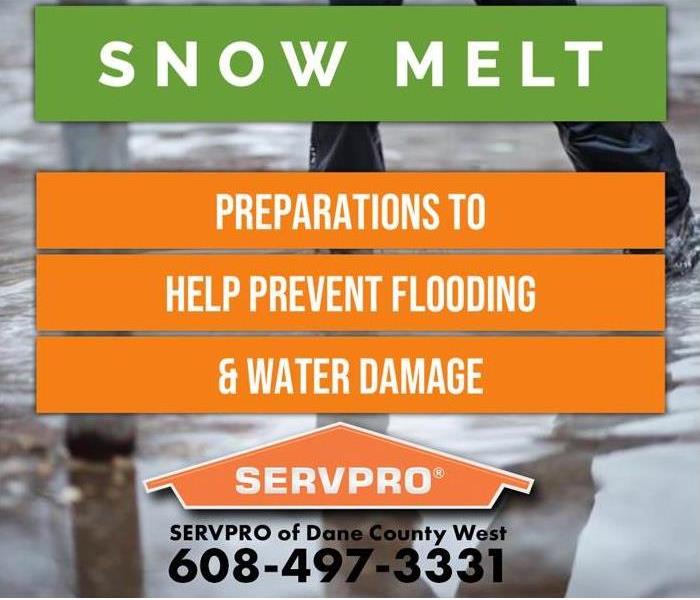Ten Ways to Minimize the Effects of Water Damage from Snow Melt in Madison, WI
4/1/2022 (Permalink)
 If flooding strikes your business or home with water damage, let us help strike back! 24/7 emergency service, SERVPRO of Dane County (608) 497-3331
If flooding strikes your business or home with water damage, let us help strike back! 24/7 emergency service, SERVPRO of Dane County (608) 497-3331
Did you know that one inch of snow on a typical roof melts into about 100 gallons of water?
Sudden rises in temperature, high-stacked snow deposits, and some additional water from rainfall are a recipe for significant flood damage. Regions like Southern Wisconsin that experienced a snowy and frigid winter are prone to significant flooding incidents when winter begins to recede.
Here are ten ways to minimize the effects of flooding and prevent water damage from snow and ice melt:
- Pay Close Attention to Forecasts Please review the following description of the four flood warnings:
- Flash Flood Warning: Issued when flooding is imminent or already occurring. If you see or hear this warning, move to higher ground because this type of flood can be a sudden and violent one. It is hard to predict how long it will last and could take minutes to hours to develop, and it can happen even in areas that are not immediately receiving water.
- Flood Warning: This kind of warning is issued when flooding is either occurring or is imminent. You need to take action and find a safe place for you and your family.
- Flood Watch: This warning is issued when the conditions are favorable for a specific hazardous weather event to happen and for flooding to be in the area. It is a preventative warning because it means that flooding could occur.
- Flood Advisory: This type of advisory is issued when flooding is not expected, but the possibility is severe enough to issue an advisory. People should take caution because the situation could change.
- Power Down Before a Flood - Power off the facility’s main breaker just before the water arrives if it seems likely that electrical outlets will be submerged.
- Seal Foundation Cracks - Keep cracks and fissures sealed up with masonry caulk or hydraulic cement to prevent leakage.
- Install a Backflow Prevention Device - Investing in a backflow prevention device can save you from costly water and sewage damage repairs. A backflow prevention device is used to protect potable water supplies from contamination or pollution due to backflow.
- Install a Sump Pump - Sump pumps keep water from rising to higher levels and drain the water. Sump pumps should be tested and maintained regularly.
- Move Valuables to Higher Ground - Move valuables like rugs, furnishings, and electronics that are below-ground areas to higher ground. Placing concrete blocks at least a foot above expected flood levels can also help if the equipment is too difficult to move above ground.
- Ground Saturation - De-Snow Your Foundation - Snow pile up against the foundation of a building can cause soil oversaturation and undermine a slab foundation or penetrate basements. The is can lead to water damage and potential mold growth in the basement. Shovel that snow pile-up back a safe distance before temperatures rise above freezing.
- Clear Out Downspouts and Sewage Drains - Unclog all downspouts, gutters, and drains before the snow melts to prevent seepage into your property.
- Watch out for Ice Dams - A roof leaking water into your interior walls, ceilings, and floors is not a pretty picture. Ice dams are a leading culprit for water leaks during the winter season. They form when heated air melts roof snow above and behind the dammed up ice when the trapped water cannot safely flow or run off the roof. Ice-dam backflows get under the roof's shingles and into interior areas.
- Remove Rooftop Snow and Inspect the Roof for Damage - Slow seepage for snowmelt on the roof can saturate insulation through holes that were small before winter began but have widened by the freeze/thaw cycle. This water seepage can cause mold growth and other damage. The weight of snow alone can cause surprising damage. One foot of snow deposited on an average roof can weigh over 18,000 pounds. The extreme weight of snow can damage the roof structure, leading to water intrusion and damage to the inside of the property.
Your facility’s roof and foundation are key areas to defending your property against annual snow and ice melt flooding. A plan to minimize snowmelt will help you save on costly water damage repairs.
Video - Rule No. 1 for Water Damage - Shut off the water at its source
If flooding strikes your business or home with water damage, let us help strike back!
Equipped with the training, tools, and experience to quickly and efficiently mitigate water or fire damage and restore your home or business, SERVPRO of Dane County West will help make it "Like it never even happened.”
- 24-Hour Emergency Service
- IICRC Certified Firm
- A+ rating from the BBB (Better Business Bureau).
- Angie's List recommended with an A-rated reputation
- 5-Star Google and Facebook rankings.
- We work with your insurance to help manage the insurance process and paperwork for a stress-free claims process.
- General Contractor License #: 1317784
What our Customers Say...Testimonials
SERVPRO of Dane County West is Here to Help® for water & fire damage, mold remediation, COVID-19 disinfection, biohazard, and rebuild. Call us at (608) 497-3331.





 24/7 Emergency Service
24/7 Emergency Service